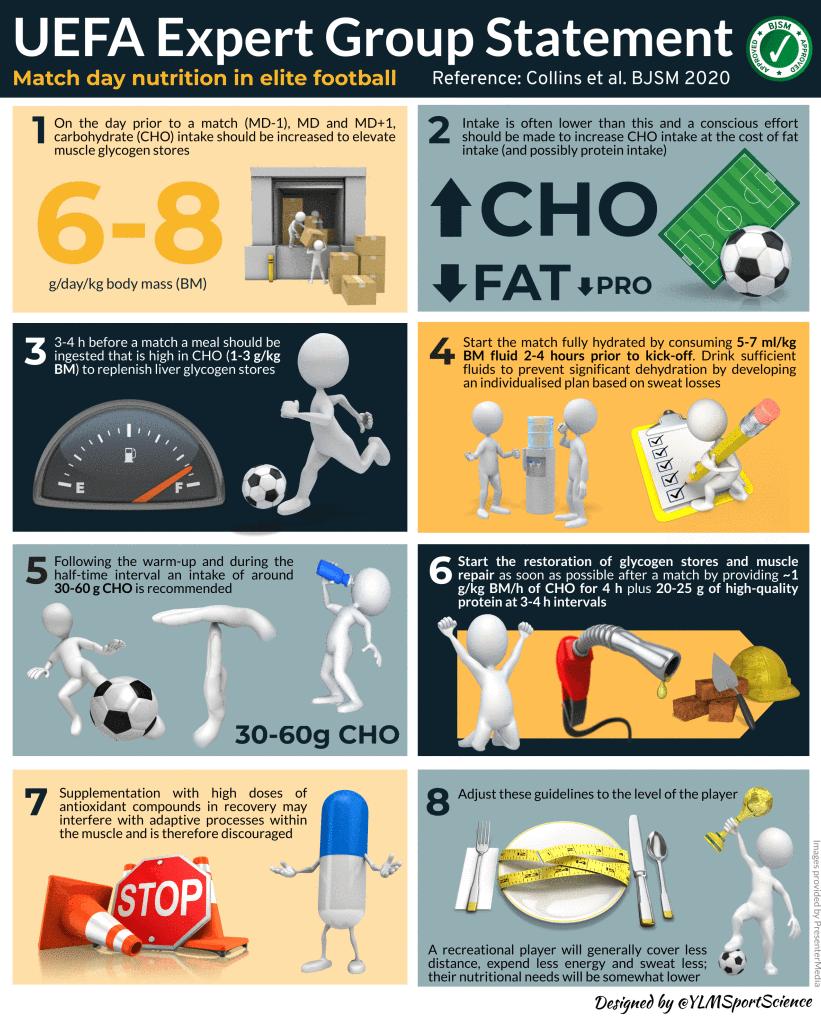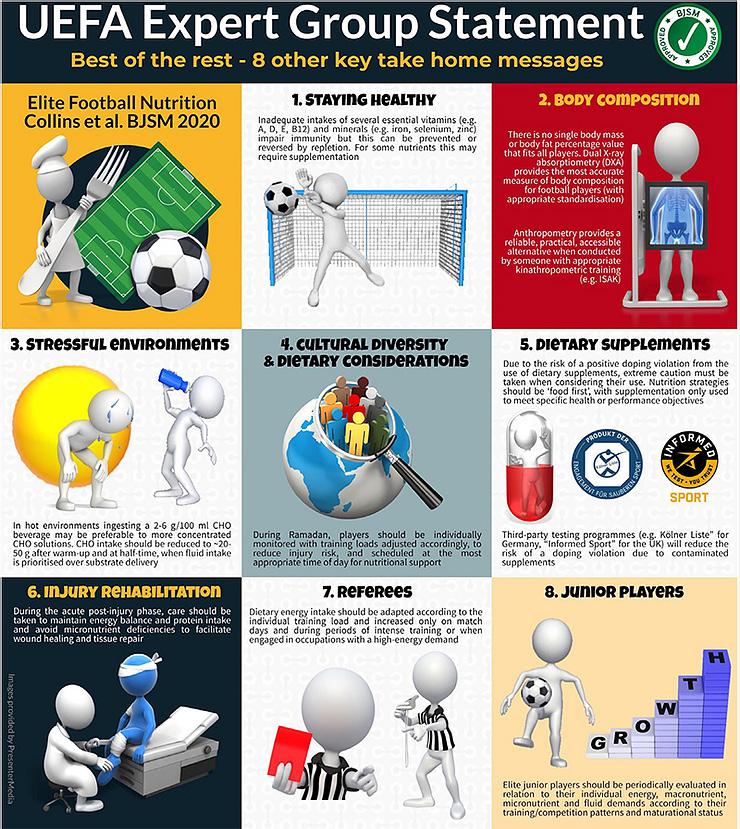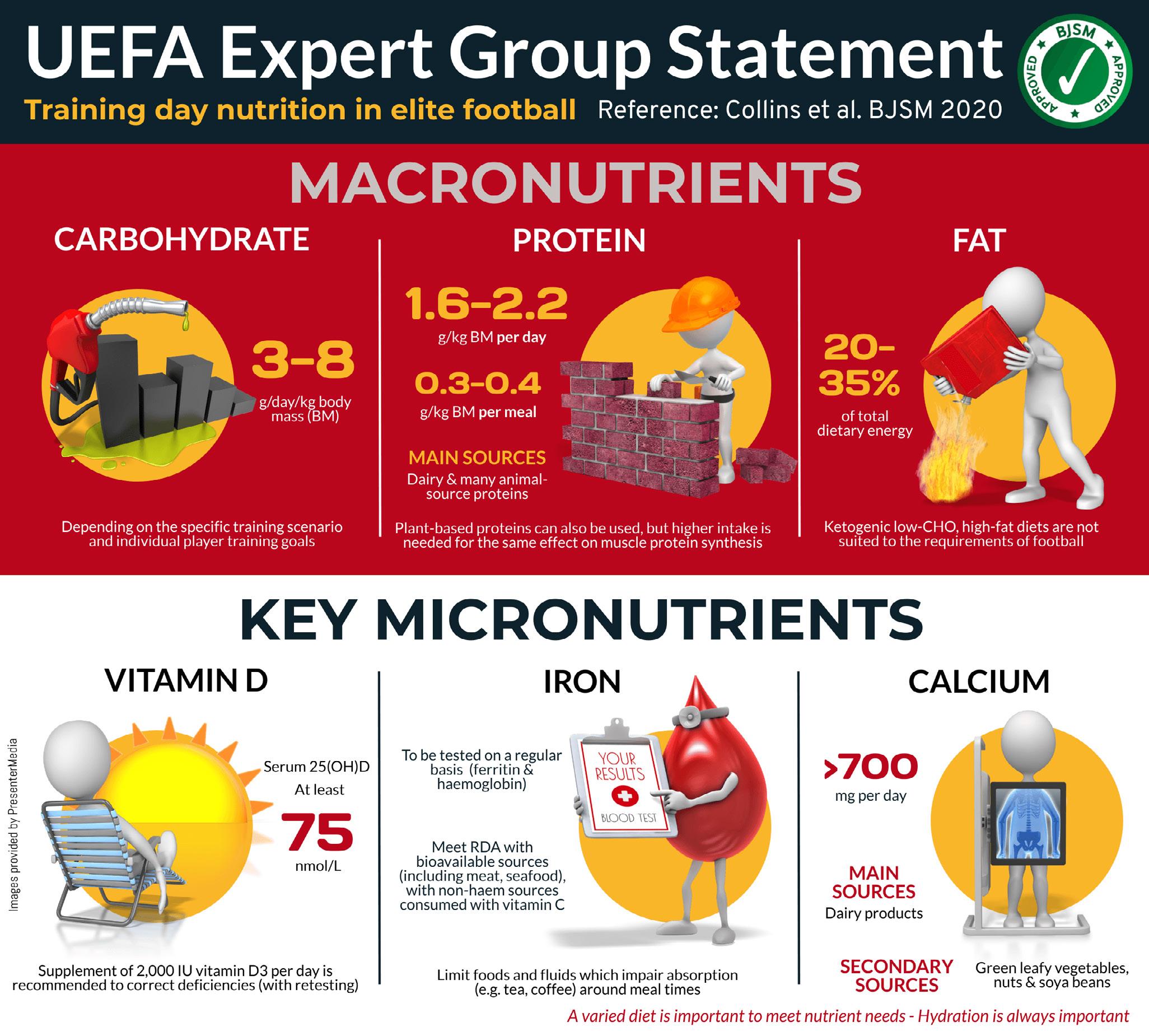
10 minute read
Defining Best-Practice Nutrition Recommendations in Professional Football: The UEFA Expert Group Statement
DEFINING BEST-PRACTICE NUTRITION RECOMMENDATIONS IN PROFESSIONAL FOOTBALL:
THE UEFA EXPERT GROUP STATEMENT
Advertisement
FEATURE / JAMES COLLINS AND ALAN MCCALL
The role and impact of nutrition on the health and performance of professional footballers is becoming more prominent within the game. Despite growing popularity and influx of research focused on football nutrition, there have been no clear guidelines for over a decade that can help practitioners make decisions that are evidence-led and practically driven. The last time the football nutrition research was collated, and recommendations given was by FIFA in 2006 (FIFA Consensus), obviously a lot has changed since then, not only in the nutrition landscape but also in the game of football itself. The physical and technical demands of the game have increased in recent years (Bush et al., 2015; Barnes et al., 2014), as well as the financial implication of winning and losing. This impacted many aspects in the sport such as training regimens, travel demands, and cultural diversity. The cultural identity has evolved with an increase in player migration moving between different countries and continents. The Expert Group Statement Process
The idea was conceived in 2016 whilst working together at Arsenal FC and we published a call for action in 2017 (Collins et al., 2017). Following conversations with UEFA at their headquarters in Nyon, they too recognised this gap and importance in providing some evidenceled recommendations for the European and indeed global football community. This is when the ‘UEFA Expert Statement on Nutrition’ project was born.
Together with UEFA, we established a steering committee of Prof. Ron Maughan, Dr Johann Bilsborough, Prof. Mike Gleeson and ourselves, where the first job of the committee was to decide the key topics that should be covered; (1) match day nutrition, (2) training day nutrition, (3) body composition, (4) stressful environments and travel, (5) cultural diversity and dietary considerations, (6) dietary supplements, (7) rehabilitation, (8) referees and (9) junior high-level players. Altogether, 31 experts were invited to collaborate on the project coming from nine countries spanning four continents, from research and practical backgrounds working within elite teams (e.g. FC Barcelona, AFC Ajax, Australia Football, French Football Federation and the Mexican Football Association). The recommendations are aimed primarily at senior professional football players (male and female) with specific sub-sections highlighting key points for junior players and also extending to top-level referees. Importantly, the UEFA expert group statement endorses and supports a ‘food first’ philosophy (Collins et al., 2020a).
The Coach’s Perspective
From the initiation of this project, it was important that this project engaged coaches, an important objective of UEFA for its 55 member associations. We secured the expertise of the iconic and long-term nutrition advocate, Arsène Wenger who has championed the importance of nutrition since working at AS Monaco back in the 1980s. He produced an editorial on ‘the
Figure 1

coach’s perspective’ (Wenger, 2020) to support the scientific guidelines.
“We often hear from the scientific community of the importance within football, but too often the voices of coaches are not heard in the best practice guidelines when they could offer valuable insight”
From Arsène Wenger editorial (http:// dx.doi.org/10.1136/bjsports-2019-101972)
Additionally, much of the nutritionrelated recommendations are historically aimed at performance enhancement, but an important focus for UEFA was to balance the performance with the health aspects of professional football players. To highlight this, UEFA’s Chairman of the Medical Committee, Tim Meyer wrote a separate editorial from the team doctor perspective’ (Meyer, 2020). “Team nutritionists and medical staff should focus intently on educating players on the various nutrients and how to include them in their daily lives. In this context, good communication between players, nutritionists and medical staff is essential”
From Tim Meyer editorial (http://dx.doi. org/10.1136/bjsports-2020-103318)
We encourage readers to read the full statement for a comprehensive understanding of the science underpinning the recommendations made. In this article for the FMPA. Here we outline some of the key (but not all) practical recommendations / ‘take-home messages’ from the matchday, training day and supplementation topics:
Matchday Nutrition
Ultimately the key objective of football is to win matches and preparing the players for the match is the central component of the multidisciplinary team (coaching, science, medical, nutrition etc). Elite football teams are often exposed to congested periods of match-play and preparation includes pre-, during and post-match (i.e. preparing for the next match by recovering optimally).
Pre-match (Carbohydrate and fluids)
Carbohydrate (CHO) is the primary fuel for muscle during high-intensity activities and is essential when preparing players for match play. On match day (MD)-1, MD and MD+1, CHO intake should be at least 6-8 g/kg BM (body mass) to elevate muscle and liver glycogen stores. During periods of fixture congestion CHO intake should be maintained at 6–8 g/kg BM/day for the 48-72 hours between matches to promote glycogen storage.
On MD itself, a CHO-rich meal should be consumed 3-4 hours before kick-off, that provides 1-3 g/kg BM, to start the match with adequate glycogen stores and to ensure no gastrointestinal problems. Liver glycogen stores can be reduced by ~50% overnight, so the pre-match meal is particularly important for early kick-off’s (those that start the match with low muscle glycogen stores, cover less high distance at much less high speed [particularly in the second half]).
Matchday CHO intake is often lower than recommended, especially during recovery following evening matches, and a conscious effort should be made to increase the intake of CHOrich foods at the cost of fat intake (and possibly protein intake). It is important that practitioners work with players to educate and adapt their nutrition strategies accordingly. Finally, players should aim to start the match euhydrated by ingesting 5–7 mL/kg BM of fluid in the 2–4hours prior to kick-off.
During match play
Following the warm-up and during the half-time interval it is recommended that ~30-60 g CHO is consumed to maintain football-related performance.
As well as starting the match hydrated, players should also drink sufficient fluids to prevent significant dehydration (>2%–3% of pre-exercise BM). It is likely that individual players

Figure 2
may be more or less sensitive to hypohydration during exercise.
Recovery from match play (CHO, fluids, protein)
After the match, it is recommended to start the restoration of glycogen and protein synthesis as soon as possible after a match by providing ~1 g/kg BM/h of CHO for 4 hours plus 20-25 g of high-quality protein at 3-4 h intervals. This is usually in the form of drinks and snacks in the changing rooms followed by post-match meals at the stadium, during travel and at home. It is important to note that players may not achieve these targets during evening matches, thus not optimising glycogen resynthesis. Particular focus should be placed on this during fixture congestion.
Training Day Nutrition
The training calendar and loading varies depending on the time of the season, match volume and individual player objectives (e.g. body fat loss or lean mass gain). Accordingly, nutrition strategies should be tailored to support training performance, recovery and adaptation to training. Within the UEFA Expert Group Statement on Nutrition, we focus on the key components of players’ training nutrition: macronutrients (carbohydrate, protein, fat), hydration, and micronutrients (vitamin D, iron calcium). Here we summarise the key findings regarding macronutrients i.e. CHO, protein and fat.
Carbohydrate requirements for training Within the UEFA Statement, we highlight how to maximise fuelling for individual players based on their specific needs. Daily CHO requirements should operate on a sliding scale of 3–8 g/ kg BM/ day depending on the training scenario, fixture schedule and individual player objectives.
This will mean deliberately increasing intakes around match day and also reducing intakes on lower loading days. The available evidence indicates that players intakes operate within ~4-6 g/ kg BM/day (Anderson et al., 2017), this is therefore an important area for practitioners to work closely with players, to educate them on how they can refine their training nutrition to meet daily targets.
Protein
With the stresses placed on players musculoskeletal and tendinous tissues, in response to intense training, it is important to repair these proteincontaining structures to maintain and improve their integrity and function. Daily intakes up to 1.6–2.2 g/kg BM/day are recommended in professional footballers. These protein needs can easily be achieved through a normal diet and ideally spaced through three to four meals during the day. High-quality proteins that are high in leucine, with dairy and many animal-sourced proteins, best to stimulate tissue protein remodelling. Plant-based proteins can also be used, but higher protein intake is needed for the same effect on muscle protein synthesis.
Fat
Dietary fat is an important part of a player’s training nutrition as an energy source, a vehicle for the intake and absorption of fat-soluble vitamins (A, D, E and K) and a source of essential fatty acids. A fat intake of 20-35% of total dietary energy is suitable for elite players. Although there is a renewed interest in fat utilisation in different exercise scenarios, due to a lack of evidence, ketogenic low-CHO, high-fat (LCHF) diets are not suited to the requirements of football.
Dietary Supplements
As highlighted earlier in this article, our UEFA philosophy is that the football players nutrition programme should be centred around a ‘food first’ policy, with supplementation only used to meet specific health or performance objectives. Due to the risk of a positive doping violation from the use of dietary supplements, extreme caution must be taken when considering their use. Within the UEFA Statement we classify these into the categories of; micronutrients, to prevent or treat deficiency (e.g. vitamin d, iron, calcium); sports foods, supply convenient macronutrients for training/matches (e.g. carbohydrate gels, protein drinks); performance, supplements which may improve performance (e.g. caffeine, creatine).
Third-party testing programmes (e.g. Kölner Liste” for Germany, “Informed Sport” for the UK) will reduce the risk of a doping violation due to contaminated supplements. This should be overseen by the team sports nutritionist and medical doctor.
Future Directions
This UEFA publication highlights just how important nutrition has become to support the modern player’s health and performance over a long season. It is important that clubs continue to develop nutrition services by strategically embedding them within the club and multidisciplinary team, and only utilising the services of qualified and registered practitioners. It is only then that the full impact of a nutrition service can be realised. Important future areas include research on both female and junior players, and incorporating sustainability principles into nutrition recommendations.
Figure 3

Steering committee, UEFA representatives and external experts
Steering Committee - James Collins, Ronald J Maughan, Michael Gleeson, Johann C Bilsborough, Alan McCall.
UEFA Representatives - Tim Meyer, Michel D’Hooghe, Charlotte Cowie, Niki Papadimitriou, Marc Vouillamoz.
Experts - Asker E Jeukendrup, James P Morton, Stuart M Phillips, Lawrence E Armstrong, Louise M Burke, Graeme L Close, Rob Duffield, Enette Larson-Meyer, Julien Louis, Daniel Medina, Flavia Meyer, Ian Rollo, Jorunn Sundgot-Borgen, Benjamin T Wall, Beatriz Boullosa, Gregory Dupont, Antonia Lizarraga, Peter Res, Mario Bizzini, Carlo Castagna, Hans Geyer.
To summarise the main recommendations, a series of infographics were produced by Dr Yann Le Meur (see figures 1-3)
Nutrition for football: the FIFA/F-MARC consensus conference. J Sports Sci 2006;24:663–4. Collins J, McCall A, Bilsborough J, et al.a Football nutrition: time for a new consensus? Br J Sports Med 2017;51): :1577–8. Barnes C, Archer DT, Hogg B, et al. The evolution of physical and technical performance parameters in the English premier League. Int J Sports Med 2014;35:1095–100. Bush M, Barnes C, Archer DT, et al. Evolution of match performance parameters for various playing positions in the English premier League. Hum Mov Sci 2015;39:1–11. Collins J, et al.b Br J Sports Med 2020;0:1–27. doi:10.1136/bjsports-2019-101961 Collins J, Maughan RJ, Gleeson M, et al Infographic. UEFA expert group 2020 statement on nutrition in elite football. British Journal of Sports Medicine Published Online First: 23 October 2020. doi: 10.1136/ bjsports-2020-103410 Wenger A. Importance of nutrition in football: the coach’s perspective British Journal of Sports Medicine Published Online First: 23 October 2020. doi: 10.1136/ bjsports-2019-101972 Meyer T. The importance of nutrition in football: perspective of a national team’s doctor. British Journal of Sports Medicine Published Online First: 23 October 2020. doi: 10.1136/bjsports-2020-103318 Anderson L, Orme P, Naughton RJ, et al. Energy intake and expenditure of professional soccer players of the English premier League: evidence of carbohydrate Periodization. Int J Sport Nutr Exerc Metab 2017;27:228–









